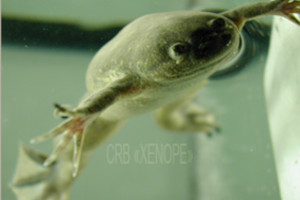Generalities
Several points explain why this model organisms is useful:
Holoblastic segmentation, specific to amphibians, allows remarkable experimental embryological approaches. It is also possible to carry out cultures of explants whose differentiation can be monitored, to microinject RNA, antisense or antibodies into targeted blastomeres at least up to the 128-cell stage.
The use of the oocyte as a test tube: large in size (1.25mm), the occyte has long been used by teams interested in the functioning of membrane channels, receptors or transporters.
Meiotic resumption is under the control of progesterone and is easily visualized by a depigmentation of the animal pole, following the expulsion of the first polar body. It is thus a model of first choice for the study of the signalling cascades that are necessary for the transition from prophase 1 to metaphase.
Absence of G1 and G2 phases during the first twelve embryonic divisions is a favourable phenomenon for the study of the cell cycle (particularly for preparation of cell extracts preparation). It also allows to work on the control of maternal RNA expression and represents a unique model for the study of the onset of transcriptional activity of the zygotic genome. The use of acellular extracts characteristic of the different phases of the cell cycle allows biochemical studies of mitotic divisions.
The metamorphosis, under the control of thyroid hormones, allows the development of fundamental research on apoptosis, but also makes the embryo an unavoidable model for the study of thyroid axis disruptors.
- Name : Xenopus laevis
- Phylogenetic classification: order Anura, family Pipidae
- Genome sequencing complete (2016)
- Genome size : 3,1 billion bp.
- Name : Xenopus tropicalis
- Phylogenetic classification: order Anura, family Pipidae
- Genome sequencing complete (2010)
-
Genome size : 1,7 billion bp.
Number of genes : about 20,000 (Hellsten et al., Science 2010).
Reproduction
Xenopes breed and reproduce in aquariums: they only come to the surface of the water to breathe. However, the conditions for breeding the X. tropicalis species are more delicate.
Xenopus laevis:
Density in the aquarium: 1 animal per 4 litres of water, temperature between 20 and 22°C, water renewal on a regular basis.
Sexual maturity appears at about a year and a half for the female and a year for the male.
Reproduction season: All year round by hormonal stimulation.
Egg-laying begins approximately 12 to 15 hours after stimulation with HCG. Females can be stimulated every three months. The eggs are then fertilised in vitro and the number of embryos at each laying is approximately 4000.
Xenopus tropicalis :
Density in the aquarium: 1 animal per 2 litres of water, temperature between 22 and 25°C, water renewal on a regular basis.
Sexual maturity appears around 4 to 6 months.
Reproduction season: all year round by hormonal stimulation.
In vitro fertilization is performed at 24°C, egg laying begins approximately 4 hours after HCG stimulation and lasts 3-4 hours. The number of embryos at each laying is about 3-4000.
Tools
- Transgenesis: coincubation of sperm nuclei, the plasmid carrying the transgene, restriction enzymes and oocyte extracts in interphase, DNA decondensation of the sperm nucleus, then injection of this preparation into unfertilized eggs (Xenopus laevis).
- Transgenesis: coinjection of a transposase, the meganuclease I-SceI, with a plasmid containing the transgene flanked by two recognition sites for the enzyme (Xenopus laevis)
- Global study of transcriptomes during development using oligonucleotide chips
- Morpholinos: Gene silencing in the early stages of development
- Oocyte: Proteins of interest production by mRNA microinjection
- Acellular extracts: Biochemical studies molecules of the cell cycle. Imaging techniques for non-invasive monitoring of embryos on a subcellular scale
Databases
Infrastructures
- Watchfrog
- https://www.watchfrog.fr/
- Evry
- Plateau technique Transgénèse des Amphibiens - Institut des Neurosciences de Paris-Saclay (Neuro-PSI)
- https://neuropsi.cnrs.fr/fr/decs/muriel-perron/plateaux-techniques/
- Gif-sur-Yvette
- Equipe Muriel Perron - Cellules souches et neurogénèse dans la rétine (SCaNR) - Institut des Neurosciences de Paris-Saclay (Neuro-PSI)
- https://neuropsi.cnrs.fr/fr/decs/muriel-perron/
- Gif-sur-Yvette
- TEFOR Paris-Saclay
- https://tps.tefor.net
- Saclay
- Centre d'exploration et de recherche fonctionnelle amphibien et poisson (CERFAP)
- https://join-the-biocluster.genopole.fr/spip.php?page=fiche-annuaire-join&id_fiche=567
- Evry
Experts
- Daniel BOUJARD
- daniel.boujard@univ-rennes1.fr
- Unité « Interactions cellulaires et moléculaires », CNRS et Université de Rennes 1
Bibliography
- Articles
